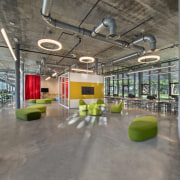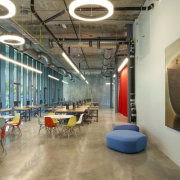University architecture studio features elegant, curving lines and floating concrete roof
Simple, curvaceous, and with a touch of Modernism about it, the sculptural new Thomas P Murphy Design Studio Building is a leader in more ways than one

Striving for architectural excellence is one thing, learning your craft within a great example of architectural excellence is quite another. Cue the graceful yet raw, concrete-and-glass addition to the University of Miami School of Architecture campus.
Continuing Arquitectonica’s long association with the university, the architectural firm has designed the school’s new Thomas P Murphy Design Studio Building – an up-to-the-minute laboratory and collaborative space for young architecture students.
The 1858m² LEED-certified building is a focused, innovative environment for students who will be the future designers of the city and further afield, says lead designer and project manager Raymond Fort.
“The building’s sculptural exposed structure of glass and concrete serves as a teaching tool by illustrating some of the basic tenets of modern architecture, construction and sustainability.”
The building is, in essence, a single, oversized shed, with a vaulted roof suspended 5.5m over the floor by narrow steel columns and a few fixed walls.
Located next to a busy campus intersection, the building includes a plaza area and adjoining pathway that links the campus to the Miami Metrorail.
“The building’s single, curved concrete wall faces the main public transit entrance and the Jorge M Perez Architecture Center that stands at the heart of the architecture school,” says Fort.
“This southern wall peels away to connect with the Perez centre’s arched portico and octagonal auditorium."
“Acting as a symbolic welcoming gesture, the curve invites students to walk up to the building. It also softens the look of the rectilinear plan.”
The roof structure creates a sense of openness and allows natural light to permeate the building.
“The roof is a thin-shell concrete structure that gives the simple building its strong visual drama,” says Fort.
“Plus, the slab warps slightly, seemingly melting in the Miami heat, to form a gentle arc that adds complexity to the silhouette of the graceful building. As well as bringing shading to the glazed east and west fronts, the bowed roof also sets up the design’s primary formal swerve.
“The curve of the roof interacts with the curve at the entrance, showing off the plasticity of concrete,” says Fort. “The two arcs transform what is a simple box into a dynamic architectural expression, incorporating core modernist principles into a progressive design that will serve as an influence for the architecture students who attend here.”

The main entrance to the building leads into an informal lobby that continues as a nave-like space running through the studio. The open-plan studio is based on a 2.3m² workstation module that can accommodate a variety of configurations for the 90 to 130 desks.
east and west walls of the central volume are clad in felt for students to pin up their work, and there are movable boards for informal critiques and exhibitions.
The studios on the south side of the circulation passage are intended for design-build courses and have direct access to the outdoor work area. Scattered cubes of different materials signify different uses within the open studio space – curtains for the jury areas, glass and panels for seminar and meeting spaces, concrete for the fabrication lab.
Two glazed freestanding pavilions serve as faculty and visiting professor offices that can be redesigned and rebuilt by students each year, providing a setting for creativity and collaboration.
And the giant multiuse studio building is just as cool in terms of sustainability as it is in terms of eye-catching, inspirational aesthetics.
The design, orientation and strategic elements of the building address the movements of the sun and ensure a sustainable work environment even in the hottest months. The concrete roof warps over the southernmost point of the building to shade the interior from sunlight.
The building can operate during daytime without the use of any artificial light, thanks in part to the first ever use of 5.5m-high hurricane-resistant glass panels – their superior strength an environmental requirement. Operable windows allow better circulation and eliminate dependence on air conditioning during the summer.
“Studios are the heart of an architecture school – a strong magnet for prospective students,” says Fort. “Hence this building. The design of the studio spaces draws together every aspect of 21C pedagogy into a cogent whole – packing everything into a deceptively simple envelope of thin concrete.”
Dean of the University of Miami School of Architecture Rodolphe el-Khoury says the design studio complements the school’s existing constellation of buildings that constitute a campus-within-the-campus.
“The vast studio space designed to enhance co-creation and the digital fabrication lab, among several other features, are welcome additions to our beloved historic and award-winning facilities.”
Credit list
Project
Design architect and architect of record
Interior designers
Acoustical
Civil
Sustainability
Client
Landscape architect
Structural
Mechanical, electrical and plumbing/fire protection
Geotechnical engineer
Construction
Story by: Charles Moxham
Photography by: Robin Hill and Miami in Focus
Home kitchen bathroom commercial design
Commercial Design Trends Vol. 35/1C
A new commercial office building can sometimes be more than just a place to work – it can also be an integral component ...
Read More














